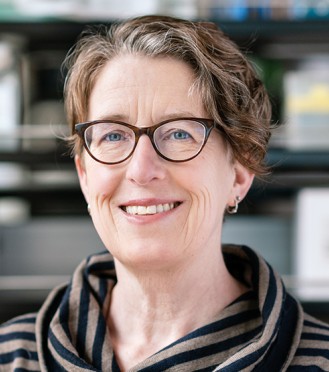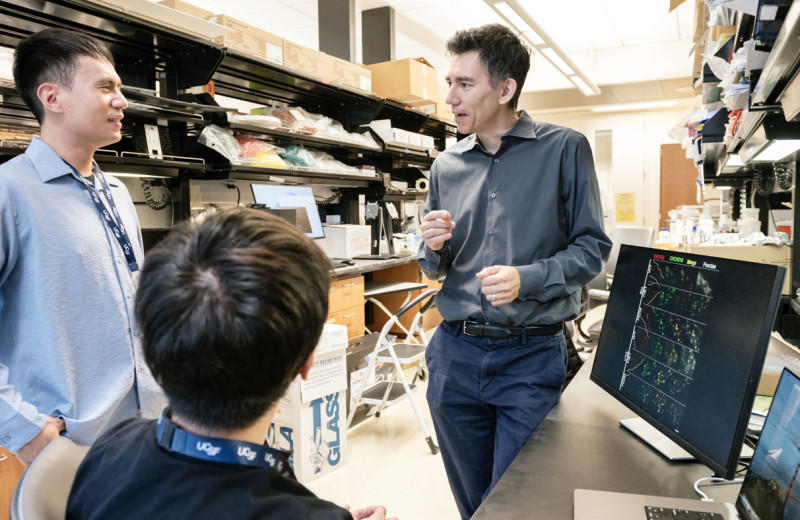Gladstone NOW: The Campaign Join Us on the Journey✕

Kathleen Keough (left) and Katie Pollard (right) showed that large structural changes to the genomes of human ancestors could have spurred the smaller changes that set human brains apart from other primates.
More than a million years ago, large chunks of the human genome were rearranged—a chance event during egg or sperm formation that led to the deletion, duplication, or reversal of sections of DNA. Those structural variants, researchers have now discovered, likely set off a cascade of other rapid changes in human DNA that may underlie uniquely human features, particularly the brain.
The new finding, published today in Science by researchers at Gladstone Institutes, came out of a study analyzing how stretches of DNA called human accelerated regions (HARs) differ between humans and chimpanzees. HARs are nearly identical among all humans, but differ between humans and all other mammals. Researchers have long wondered why these sequences—many of which control brain development—changed so rapidly in early human evolution.
“What we found is that many HARs are in regions of DNA where structural variants caused the genome to fold differently in humans compared to other primates,” says Katie Pollard, PhD, director of the Gladstone Institute of Data Science and Biotechnology and lead author of the new study. “This gave us an idea how HARs could have arisen in the first place.”

Keough (left), Pollard (right), and their team collaborated with The Zoonomia Project to better understand the origin of uniquely human regions of DNA called HARs.
Folding like Origami
When comparing human and chimpanzee genomes nearly two decades ago, Pollard discovered regions of DNA—now called HARs—that were stable in mammals for millennia, but suddenly changed in early humans. Her lab has since shown that most HARs are enhancers, short stretches of DNA that regulate the activity of genes related to brain development. But researchers still have many questions about how HARs came about and the role they play in making humans distinct from other primates.
Pollard and her colleagues wondered whether other changes to the DNA surrounding HARs might help explain their origin. In collaboration with The Zoonomia Project, an international collaboration to study mammalian genomes, the researchers analyzed HARs and their surroundings in 241 mammalian genomes. They concluded that HARs tend to be located in areas of the human genome that have large structural differences when compared to other mammals.
So, the scientists next probed whether the structural variations around HARs might have changed the way the DNA folded.
“The way the genome folds up in three-dimensional space like origami is particularly important for enhancers,” explains Pollard, who is also a professor at UC San Francisco and a Chan Zuckerberg Biohub investigator. “That’s because enhancers can impact the activity of any gene that ends up close by, which can vary depending on how DNA is folded.”

Keough (left) and Pollard (right) used a machine learning model and lab experiments to compare human and chimpanzee DNA sequences and identify regions of the genome that fold differently in humans.
To study the relationship between HARs and DNA folding, Pollard’s team used a machine learning model they previously developed to predict DNA folding patterns, and applied it to human and chimpanzee DNA sequences. Then, they identified the regions of the genome that folded differently in humans. The computer predicted that nearly 30 percent of HARs were in areas of the genome that folded differently in humans compared to chimpanzees.
“We realized that these human-specific structural changes may have created the right environment for HARs to evolve fast in the human ancestor, after remaining almost the same over millions of years of mammal evolution,” said Kathleen Keough, PhD, first author of the study and former postdoctoral scholar in the Pollard lab at Gladstone.
Piecing Together the Past
If DNA near HARs folded differently in humans and brought different genes in proximity to HARs, this could have had drastic consequences for our ancestors.
“Imagine you’re an enhancer controlling blood hormone levels, and then the DNA folds in a new way and suddenly, you’re sitting next to a neurotransmitter gene and need to regulate chemical levels in the brain instead of in the blood,” says Pollard. “Your instructions are now out-of-date and need to be changed.”
The predictions from the machine learning model suggested that large structural changes had occurred near HARs, but did not demonstrate which genes had fallen under their control. To address that question, Pollard and her colleagues carried out lab experiments that let them determine, in human and chimpanzee brain cells they derived from stem cells, what stretches of DNA were closest to hundreds of different HARs.
In many cases, they found, the human HARs were close to genes known to play a role in brain development; in some instances, the nearby genes were also associated with neurodevelopmental or psychiatric diseases.

Pollard (left) and Keough (right) found that many HARs are close to genes that play a role in brain development.
Pollard’s team recently reported that the variations that rapidly appeared in HARs during early human evolution often opposed each other, first turning up the activity of an enhancer and then turning it down, or vice versa. The new results, she says, fit in well with the model proposed in that study.
“Something big happens like this massive change in genome folding, and our cells have to quickly fix it to avoid an evolutionary disadvantage,” said Pollard. “But the fix might kind of overdo it and need to be refined over time.”
While the new paper helps answer how HARs may have emerged in the beginning, Pollard’s team still has questions they plan to follow up on about why the massive structural changes survived the test of time and how HARs impact human brain development.
For Media
Julie Langelier
Associate Director, Communications
415.734.5000
Email
About the Study
The paper “Three-dimensional genome rewiring in loci with human accelerated regions” was published in the journal Science on April 28, 2023.
Other authors are Sean Whalen and Pawel Przytycki of Gladstone; Fumitaka Inoue, Tyler Fair, Chengyu Deng, Marilyn Steyert, Hane Ryu, Tomasz Nowakowski, Nadav Ahituv, and Alex Pollen of UCSF; and Kerstin Lindblad-Toh and Elinor Karlsson of Broad Institute of Harvard and MIT.
The work was supported by a UCSF Discovery Fellowship, the National Institutes of Health (GR-01125, DP2MH122400-01, NHGRI R01HG008742), the National Institute of Mental Health (R01MH109907, U01MH116438), the Schmidt Futures Foundation, the Shurl and Kay Curci Foundation, and a Swedish Research Council Distinguished Professor Award.
About Gladstone Institutes
Gladstone Institutes is an independent, nonprofit life science research organization that uses visionary science and technology to overcome disease. Established in 1979, it is located in the epicenter of biomedical and technological innovation, in the Mission Bay neighborhood of San Francisco. Gladstone has created a research model that disrupts how science is done, funds big ideas, and attracts the brightest minds.
Want to Join the Team?
Our people are our most important asset. We offer a wide array of career opportunities both in our administrative offices and in our labs.
Explore CareersSix Gladstone Scientists Named Among World’s Most Highly Cited Researchers
Six Gladstone Scientists Named Among World’s Most Highly Cited Researchers
The featured scientists include global leaders in gene editing, data science, and immunology.
Awards News Release Corces Lab Doudna Lab Marson Lab Pollard Lab Ye LabThe Genome Editing Playbook Is Different in Neurons
The Genome Editing Playbook Is Different in Neurons
The striking findings of a new study could influence how gene therapies are designed for many genetic diseases.
News Release Research (Publication) Neurological Disease Conklin Lab Doudna Lab CRISPR/Gene EditingEvidence Builds for Disrupted Mitochondria as Cause of Parkinson’s
Evidence Builds for Disrupted Mitochondria as Cause of Parkinson’s
A new study from Gladstone Institutes strengthens the links between energy breakdown in cells and the onset of Parkinson’s, potentially illuminating new paths for treatment.
News Release Research (Publication) Parkinson’s Disease Neurological Disease Nakamura Lab




